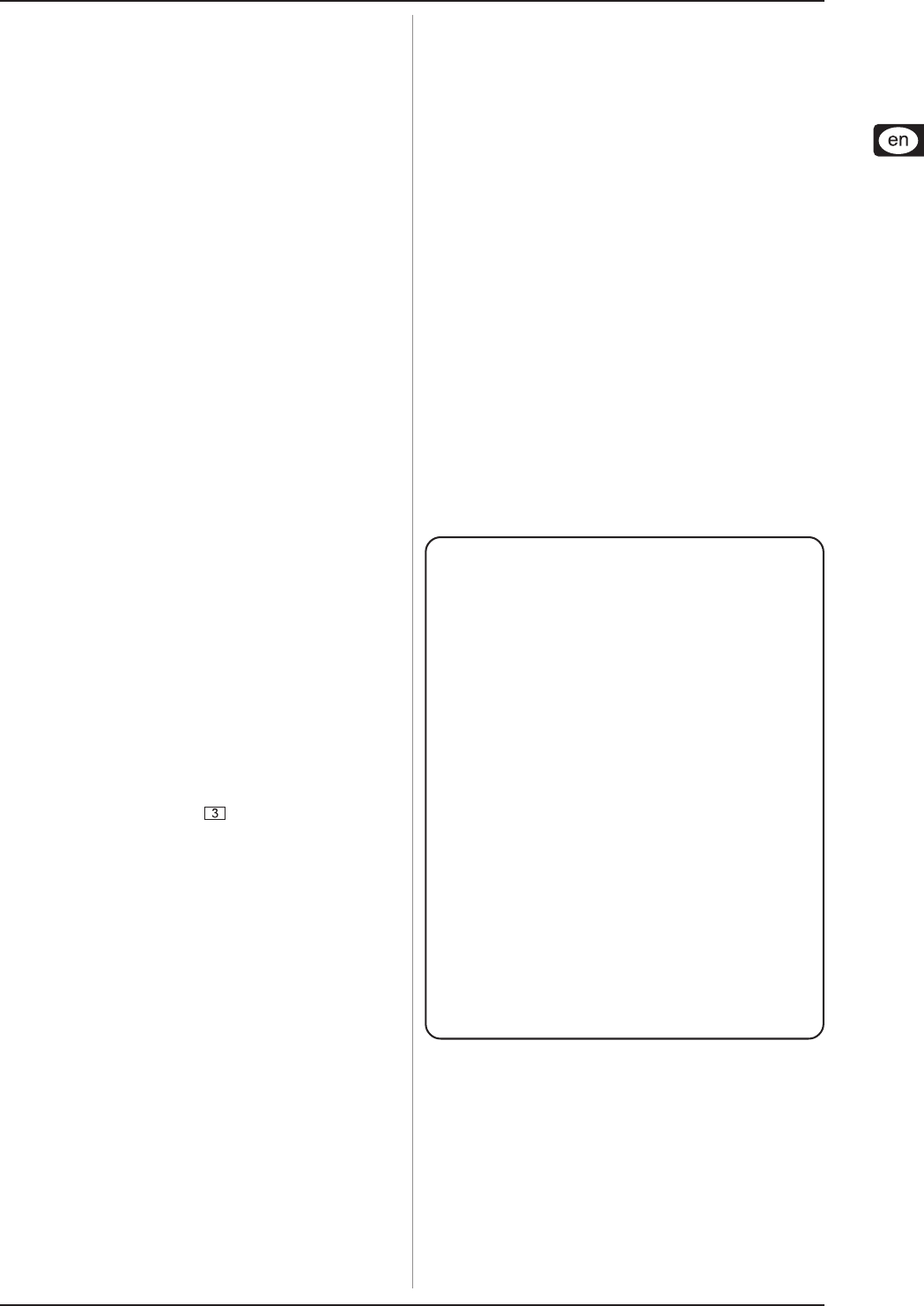
17
U-CONTROL UMA25S
5.5.5 Pitch Bend
The Pitch Bend wheel E17 on the UMA25S is used to change the
pitch of a note. It has its own type of message in the MIDI
specification.
The Pitch Wheel message can also be assigned to other
continuous elements (such as slider, knobs and expression
pedal). This message has its own status byte, so that it is only
possible to adjust the MIDI channel (E10 rotary knob), the range
(E12 rotary knob) and the display (E16).
Table A.5 on the supplementary sheet gives you an
overview of the rotary knob assignment in
Edit Mode.
5.5.6 After-Touch
MIDI keyboards with after-touch are able to respond to pressure,
even after the key is hit, and to transmit this information. The
function affects either specific keys (Key Pressure) or all notes
equally (Channel Pressure). The UMA25S keyboard is not after-
touch capable, but you can assign this function to other control
elements. This way you can control synthesizer parameters
that are used to control after-touch.
Normally, the key value “All” is selected. This setting makes after-
touch equally affect all played notes (“Channel Pressure”). In
case you want to use the less common polyphonic after-touch
(“Key Pressure”), you can apply after-touch to single keys by
using the E11 rotary knob. However, since this is only supported
by very few sound generators, Channel Pressure usually does
the job. For the selected switch element, use E12 to determine
the value at which after-touch turns on and E13 to determine the
value at which it turns off. This way you can also use after-
touch to adjust the modulation range (effect depth).
Table A.6 on the supplementary sheet gives you an
overview of the rotary knob assignment in
Edit Mode.
5.5.7 MIDI Machine Control (MMC)
MIDI Machine Control allows you to operate the transport functions
of a sequencer or drum machine (for example, Start, Stop, Fast
Forward and Rewind) from the UMA25S.
The MIDI Machine Control functions are dedicated to the control
push buttons E1 – E8 (see Chapter 5.2.3) and are activated by
pressing the MMC push button . You can specify the MIDI
device number of the unit supposed to receive MMC data by
using the E10 knob. For the Locate function, it is necessary to
specify the position. In order to do so, the Frame Rate you are
using has to be entered in Global Setup (Chapter 5.7).
Table A.7 on the supplementary sheet gives you
an overview of the rotary knob assignment in
Edit Mode.
5.5.8 GS/XG parameters
GS/XG parameters belong to the category of CC and NRPN
messages specified in the MIDI standards GM (General MIDI), GS
(Roland) and XG (Yamaha) (see Table 7.1). These standards
also include dedicated program numbers for certain sounds. If
you have a sound module that supports one of the standards,
assigning parameters is as easy as it gets.
The data have a similar structure to that of CC and NRPN
messages. Use the E11 rotary knob to select the most important
GS/XG-compatible parameters, which are shown on the display
as (shortened) plain text (see Table 7.1).
Just like the CC messages, the value range can be adjusted with
the rotary knobs E12 (minimum value) and E13 (maximum value).
Table A.8 on the supplementary sheet gives you an
overview of the rotary knob assignment in
Edit Mode.
5. UMA25S as USB/MIDI controller
5.5.9 Using keys as control elements
Not only the switch elements but also the keys on the keyboard
can trigger CC messages and Note messages. The advantage is
that you don’t have to do without the familiar feel of keys and
velocity sensitivity. This means you have 25 more switch
elements at your fingertips, with Note numbers that are freely
assignable (which is different to standard keyboard assignments).
This is useful when extracting individual drum sounds from a
fixed assignment (for example, a General MIDI drum set) in order
to map them to adjacent keys, even when the sounds are octaves
apart. Another option is to map the notes of a melody to adjacent
keys in order to play the melody literally in sequence.
Triggering Note messages with keys:
The data structure corresponds to that of the Note messages,
except for the Velocity, which can be played either with a fix
value (0 – 127) or with the Velocity of the keyboard (E12 rotary
knob). Turn E15 to discard the settings and return to the normal
assignment of the keyboard (Reset function; “reS” on display).
Triggering CC messages with keys:
The data structure corresponds to that of the CC messages for
switching elements, which can be played either with a fix value
(0 – 127) or with the Velocity of the keyboard (E12 rotary knob).
The switch behavior is determined with E14. Turn E15 to discard
the settings (“reS” on display).
Table A.9 on the supplementary sheet gives you an
overview of the rotary knob assignment in Edit
Mode.
Selecting multiple keys for the Key Trigger
function:
A special feature of the keyboard assignment lets you
select multiple keys at the same time. This helps you save
time when assigning messages, some of which are
identical, or MIDI channels to different keys. In a second
step you can assign different MIDI channels, Note values
and Controller values to individual keys.
1. Press and hold down the EDIT/EXIT push button.
The device switches to Edit Mode.
2. Press the keys that you want to edit one after
another. You can either select consecutive keys or
choose a range of the keyboard with a sliding
movement (glissando). It is also possible to select
single, non-consecutive keys. The Note numbers
you choose are now shown on the display in the
order in which they are pressed.
3. Release the EDIT/EXIT push button.
4. With the rotary knobs, you can carry out the
assignment of the MIDI messages for the selected
keys.
5. Press the ENTER key to confirm.
6. Save the assignments as preset.


















